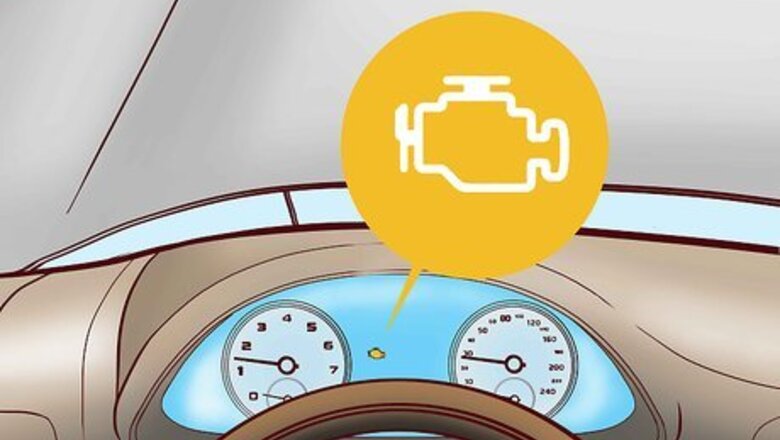
views
Spotting the Signs of a Problem with the Tension

Look for a warning light on your dashboard. Most vehicles come equipped with an ignition or voltage warning light, which can be a sign of a slipping serpentine belt. As the belt gets loose, it will fail to spin the alternator pulley, resulting in a drop of electrical current within the car’s engine, prompting the warning light. The warning light usually looks like a rectangle or the top of a 9 volt battery, with a minus sign on the left and a plus sign on the right. This warning light may also indicate a failing alternator or a battery that is no longer holding a charge.

Pay attention to the engine’s temperature gauge. If the serpentine belt is too loose, it may not adequately power the vehicle’s water pump (which pumps water and coolant throughout the engine). If the engine temperature gauge begins to climb outside of its normal range, it may be due to a slipping serpentine belt. Your first sign of a loose serpentine belt may actually be the vehicle overheating if it fails to spin the water pump pulley. If at all possible, avoid allowing the vehicle to overheat, as it can cause permanent and expensive damage to the cylinder head.

Listen for belt squealing. A loose serpentine belt will often produce an audible squeal in the engine bay. This is often the first sign of a loosening serpentine belt and may mean the belt is either too loose or is overly worn. However, a squealing belt may also be a sign that one of the accessories it drives is beginning to fail. A squeal that begins only when you start the car cold may be a strong sign of a loose belt. A squeal the coincides with the car’s acceleration is also likely due to a loose belt.
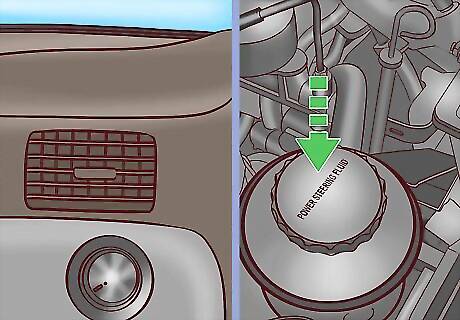
Take note if your air conditioner or power steering begin to fail. Because the air conditioner and power steering in your vehicle are both powered by the serpentine belt, a loose belt may result in both or either failing to work or behaving oddly. A loose belt may even cause both to work intermittently. A lack of cold air from the air conditioning and and increase in tension in the steering wheel are both signs of these accessories failing. Be sure to check the power steering fluid if you begin to have issues with your power steering.
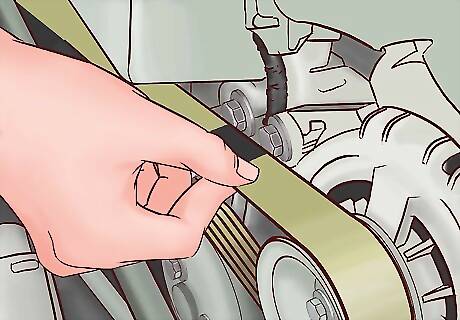
Check the belt’s tension if pulleys begin to fail. The serpentine belt is routed around pulleys that drive your vehicle’s accessories. If a pulley on one of the accessories seizes or fails to turn it will likely destroy the serpentine belt, but it’s important to consider that a belt that’s too tight will often lead to seizing pulleys. You will need to remove the belt to replace the damaged accessories or pulleys if one fails. Ensure you put the new belt on with the correct tension, otherwise more accessories may fail.
Inspecting the Belt for Tension Issues
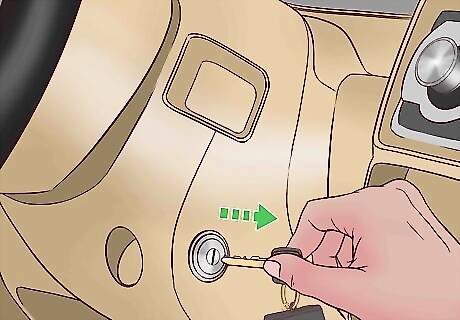
Turn the vehicle off and remove the keys from the ignition. While you may want to inspect the belt with the motor running to identify the source of a squeal, you will need to turn it off in order to closely inspect the belt. Do not get close to the belt until the engine is safely off. Removing the keys from the ignition is a safety precaution that could prevent you from getting hurt or damaging the vehicle. You may also want to disconnect the negative terminal of the battery. Serpentine belts move at high rates of speed and can catch any loose fitting clothing or jewelry if you get close while the engine is running.
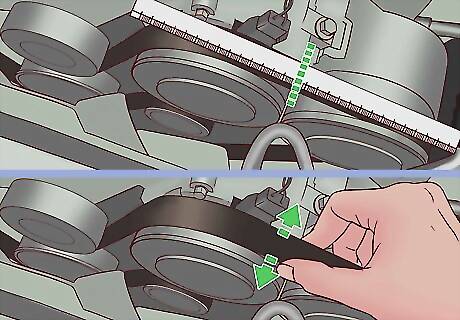
Use a ruler to check the belt’s tension. In many applications, the serpentine belt needs only to be reasonably tight. Because of this, a belt tension gauge is not necessary for most vehicles. Instead, use a ruler to measure the distance between the two furthest pulleys and find the midway point. Pinch that point between your index finger and thumb and move it back and forth. The belt should have about a half an inch of play when at the appropriate tightness. If there is less than a half an inch, the belt will need to be loosened, if there is more, it will need to be tightened. Leaving the ruler over where the belt was as you press on it can help make the amount of flex in the belt more apparent by showing how far it’s flexing from the ruler.

Check for cracks and microcracks on the inside of the belt. While all serpentine belts are prone to cracking as they wear and age, a loosely fitting belt will wear more quickly on the interior of the belt, and will often show cracks before they show on the outside, or back, of the belt as is common with age. The inside of the belt is the side with grooved edges. If the belt is cracked, it will need to be replaced.
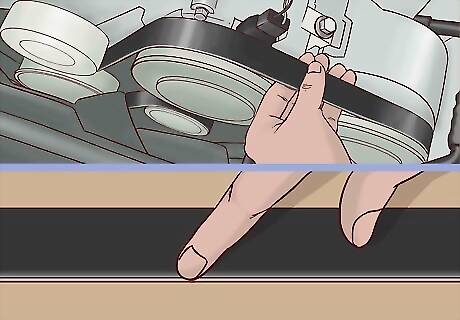
Look for polished edges on the belt. The serpentine belt should not be able to wander from side to side while in operation, but if its loose, it may do so, rubbing up against the lip of pulleys and creating a shiny or polished edge to the belt. If the edges of your serpentine belt are shiny, the belt is too loose and needs to be tightened. If the belt is showing sign of wear like polished edges, it likely will need to be replaced. A frayed belt edge, however, means the belt is misaligned.
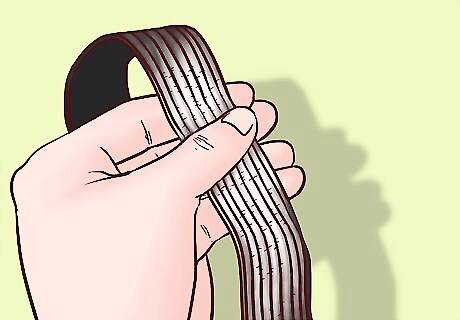
Check the belt grooves for glazing. If the serpentine belt is loose, the belt grooves may begin to melt and glaze over. Glazing is easy to spot, as it will look shinier than the rest of the rubber the belt is made of. Glazing occurs as the belt passes over pulleys without placing enough tension on them to actually make them turn with the belt. If the grooves of the belt have glazed over, you’ll need to replace the belt. Glazing may occur in conjunction with cracking as described in the step above.
Using a Gauge to Check Belt Tension
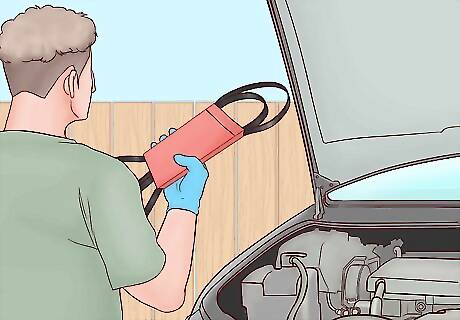
Inspect the belt for damage. If the belt needs to be replaced, you may not desire to check the belt for the correct level of tension because it will need to be removed and replaced anyway. You may still want to check the tension of a damaged belt if you need to drive the vehicle to get repaired. It is not recommended that you operate a vehicle with a damaged, loose, or severely worn serpentine belt.
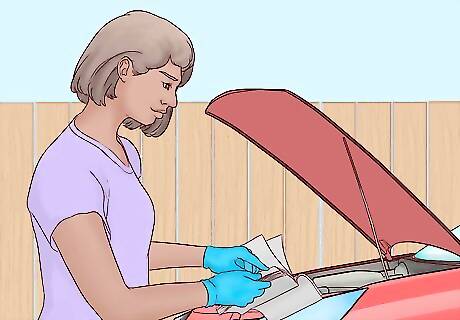
Locate your vehicle’s specifications. In order to use a tension gauge properly, you’ll need to know the specific manufacturer’s specifications for belt tension. This information can often be found in the vehicle’s owner’s manual or in certified repair manuals for your specific year, make and model. If you do not have the owner’s manual for your vehicle, you may be able to find the specifications on the manufacturer’s website.
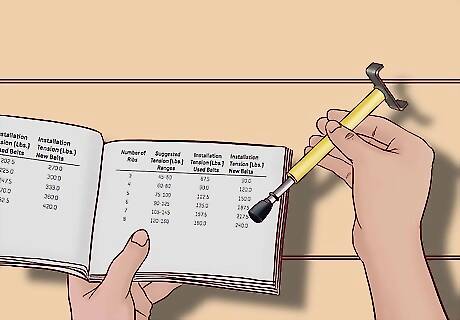
Read the instructions on your tension gauge. There are a number of different kinds of tensioner gauges you may choose. Some are vehicle specific, while others are not even specific to vehicles at all, but they all serve the same general purpose: determining the amount of force the belt can withstand before it begins to move. Some tension gauges work my pushing on the belt, while others work by pulling on it. Your specific tension gauge will provide instructions as to how best to use it to get the best reading.
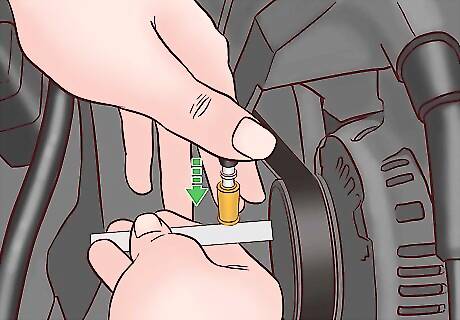
Press or pull the gauge into the belt at the midsection in the largest gap between pulleys. Testing belt tension at a spot on the belt that’s stretched between two nearby pulleys will give you a falsely taught reading. Instead, find the portion of the belt that is stretched the furthest between two pulleys and use the gauge there. If your specific gauge instructs you to do otherwise, disregard this step. Slow steady pressure (when pushing or pulling) is the best way to get an accurate reading from your gauge.

Compare the number provided by your gauge to the vehicles specifications. Refer to the number you got from the vehicle’s owner’s or repair manual to determine to see if it matches the figure on the guage. If the numbers don’t match within reason, the belt will need to be adjusted. Some vehicles have an auto-tensioner pulley. If your vehicle has one and the belt is too loose, the pulley itself may need to be replaced. Other vehicles may allow you to adjust the tension on the belt by loosening the alternator bolts and adjusting its positioning.




















Comments
0 comment